The USA have for so long been the dominant power in international women’s football, winning multiple World Cups and Olympic golds. However, they have not been themselves at the 2020 Olympics, with their semi-final loss to Canada a clear sign of that. In what can be labelled a “North American derby”, the reigning world champions were sloppy and never looked like getting into the game, whilst Canada were excellent and controlled proceedings well. USA head coach Vlatko Andonovski’s tactics will no doubt be scrutinised in the coming weeks, but forward Megan Rapinoe said after the defeat that the players needed to look at themselves as well.
This tactical analysis will look at the USA’s performance in this game, particularly in attack, finding the reasons for their defeat. The analysis will also focus on Canada’s game control and pressing tactics, seeing how both helped them to win the game and advance to the final.
Lineups

The USA made three changes to the team that defeated the Netherlands on penalties in the quarter-finals, changing their system from a 4-3-3 to a 4-2-3-1. Manchester City Women centre-back Abby Dahlkemper, former City midfielder Sam Mewis, now with North Carolina Courage, and NY/NJ Gotham’s veteran striker Carli Lloyd all dropped out of the starting XI. OL Reign’s Rose Lavelle, also formerly of Manchester City, started behind Orlando Pride striker Alex Morgan, who took Lloyd’s place in attack, whilst Chicago Red Stars’ Tierna Davidson partnered captain and Portland Thorns veteran Becky Sauerbrunn in the defence.
Canada also changed their system, having beaten Brazil in a penalty shoot-out to reach this stage of the tournament. They went from a 4-3-3 to a 4-3-1-2, but without making personnel changes. Instead, Chelsea Women’s Jessie Fleming and OL Reign’s Quinn moved back to play alongside experienced Desiree Scott, instead of just in front of her, whilst legendary forward Christine Sinclair played in an attacking midfield role, with Manchester City’s Janine Beckie and Houston Dash’s Nichelle Prince in front of her. The intention was for Sinclair to dictate the play from behind the forward line, whilst Beckie and Prince were given freedom to attack with pace.
The USA’s attack
The USA are used to winning games at major tournaments but had not been at their best in this one, as highlighted by their opening round defeat to Sweden. They did comfortably defeat New Zealand but struggled to a goalless draw against Australia – so their group stage results had been mixed.

They hadn’t made massive tactical changes coming into the Olympics, with their main aim still being to have numbers in the final third to create plenty of options. Their full-backs are tasked with controlling the wings, and Washington Spirit right-back Kelley O’Hara has advanced into Canada’s half here, with five teammates ahead of her. However, the reason they struggled to make these situations count was because Canada were alive to this, bringing their midfielders back to support the defenders, and the extra numbers allowed them to close the ball down and mark the USA’s attackers simultaneously. The USA constantly looked to get balls into the box from these wide areas, but Canada’s defence was resolute and cleared every cross that came in.

Whilst Canada’s good play was the reason for that tactic not working, the other reason the USA struggled to build any momentum in attack was because they continuously made mistakes with the ball. Here, former Manchester United Women forward Tobin Heath has passed infield to Julie Ertz, with Canada blocking her path on the wing. However, she overhit her pass, as well as lacking accuracy – both of which meant the Chicago midfielder couldn’t control it. As a result, the ball went loose, and Canada came forward to retake possession, launching an attack, so the USA needed to have more composure when in these areas.
Having Sam Mewis in the team might have improved this, as she tends to get into spaces where she can link up play for her team, as well as having a good passing accuracy. Therefore, she would have helped the USA to keep possession of the ball, which could have allowed them to pose more of a threat in the final third.
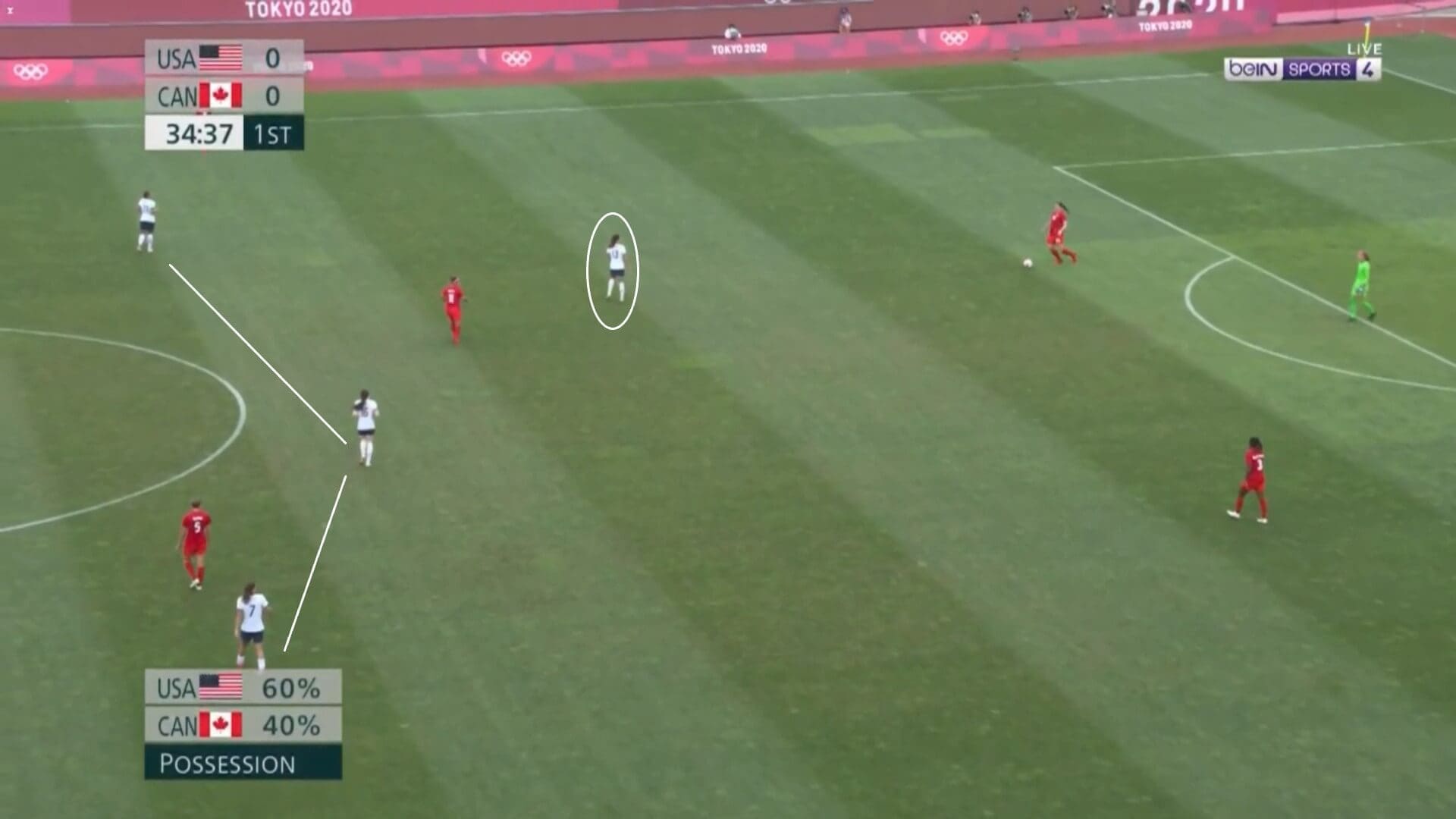
It wasn’t just individual errors that cost the USA the win though. Structurally, they looked unsure of themselves and didn’t put Canada under any pressure when the Canadians had the ball. This was likely down to the decision to start with one striker, Alex Morgan, and have three players behind her, in Heath, Lavelle and North Carolina’s Lynn Williams. As this image shows, the three behind Morgan didn’t get forward to support her, which gave the defenders time and space to play around the former Tottenham Hotspur Women striker. We are used to seeing the USA try to win the ball back once they had lost it, but they lacked the necessary urgency to do that, meaning it was easy for Canada to clear their lines every time the ball was in their third.
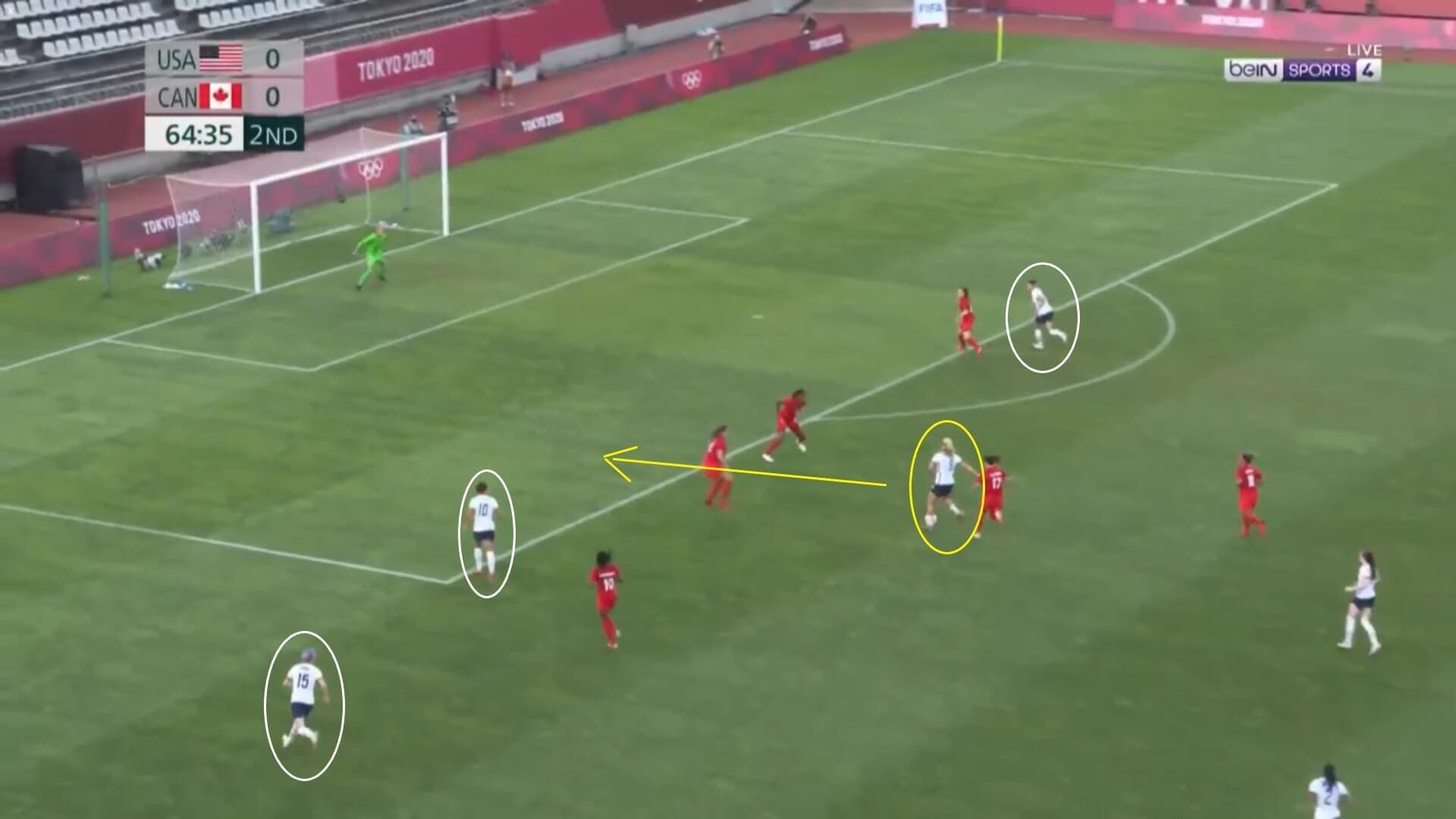
Given their lack of threat in the first half, it was unsurprising that the USA made tactical changes at half-time. Portland Thorns’ Lindsey Horan, who had been playing alongside Ertz in the defensive midfield area, got into more advanced positions in the second half, creating passing options from the left side of the pitch. This seemed to work, as they looked more like the USA we are used to seeing, and Canada had to think more carefully as a result.
However, they still weren’t getting behind the defence, and when Andonovski made his first substitutions of the game, it was to take off Morgan, Heath and Williams, replacing them with Carli Lloyd, Christen Press (also formerly of Manchester United) and Megan Rapinoe. Lavelle dropped back into the midfield, with the whole team looking more comfortable in this formation. All three of the new attackers made runs behind the Canadian defence, with Rapinoe in particular causing all sorts of problems with her speed and accurate crossing from the left-wing.
This image demonstrates this point, with Horan back in a central position behind them. With the USA getting into more dangerous areas, the Canadian defence had to get further back to close off the spaces, which gave the USA more space to play in centrally. As a result, Horan could get closer to the box before releasing the ball, increasing the accuracy of the pass and allowing her teammates to get shots on target. This begs the question of why they didn’t start with this setup, and that is one question that Andonovski may have to answer in the coming weeks.
Canada’s pressing
We have so far looked at the problems the USA had, but we will now focus on Canada, looking at the tactics that enabled them to win the game. The most noticeable thing about their performance was their pressing all over the pitch, never giving the USA any time on the ball.

In attack, the trio of Beckie, Prince and Sinclair were never far from each other, ensuring that Canada always had options in the final third. We mentioned at the beginning that the reason for playing Sinclair behind the attackers was to give Canada a playmaker in the final third, and this image shows the effect that had on their play. Beckie and Prince have got up to Becky Sauerbrunn, whilst Sinclair has stayed back to prevent the ball being passed between them and into the midfield, so their positioning and communication were essential to keeping the USA on the back foot.
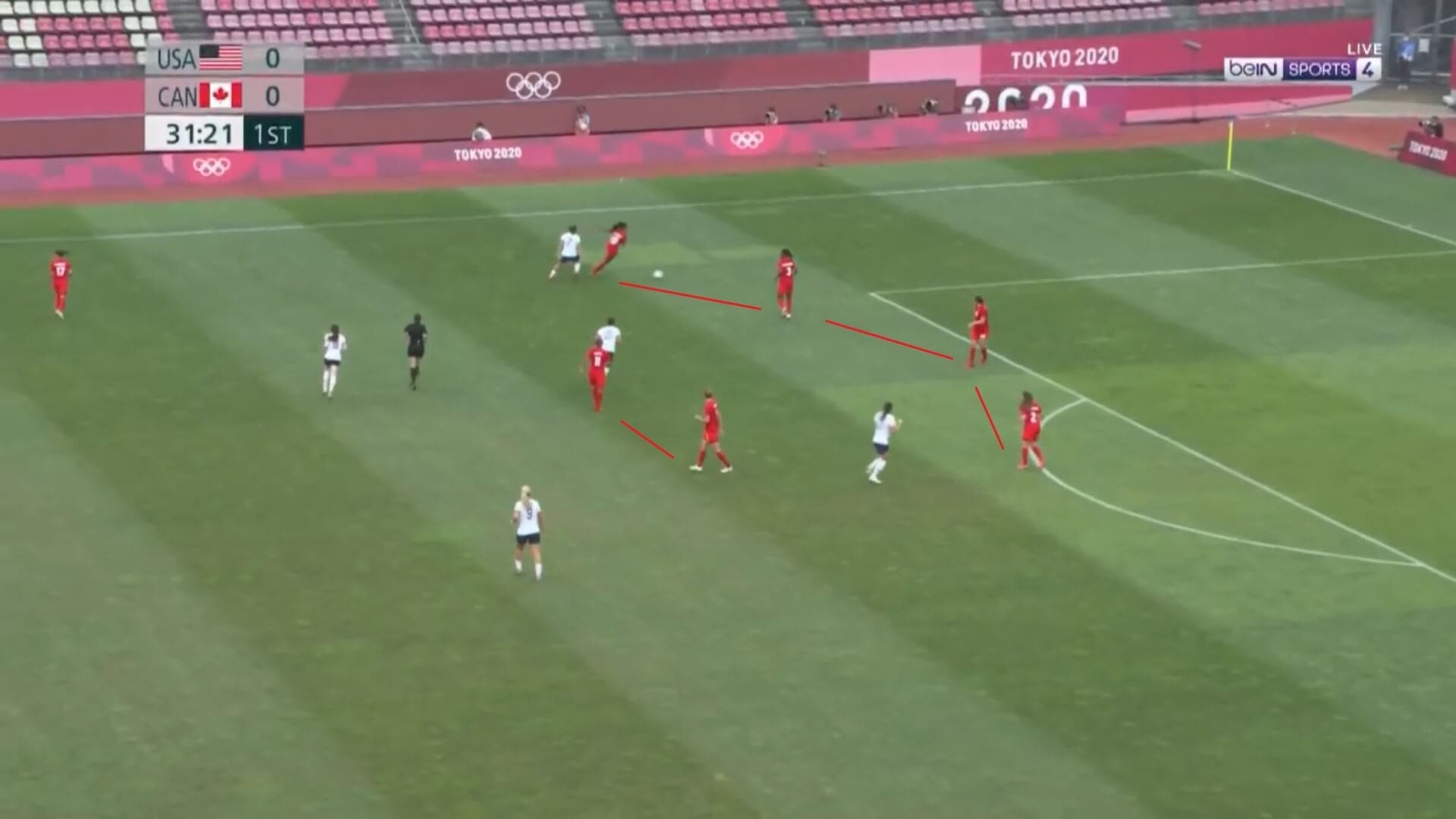
When the USA were attacking, Canada got back to limit the space they had to operate in, as shown here. The USA have been forced to take the ball to the far side of the pitch, and we mentioned previously how a key part of Canada’s defensive tactics was to bring the midfield back to increase their numbers, and that is shown here too. Fleming and Quinn have both dropped back to help squeeze the USA into a narrow corridor just outside the goal area, and this made it hard for the USA to create goalscoring opportunities. Canada’s PSG Feminines right-back Ashley Lawrence constantly made successful tackles whenever the ball came near her, so whenever Canada forced the USA into her path, they tended to win back possession.
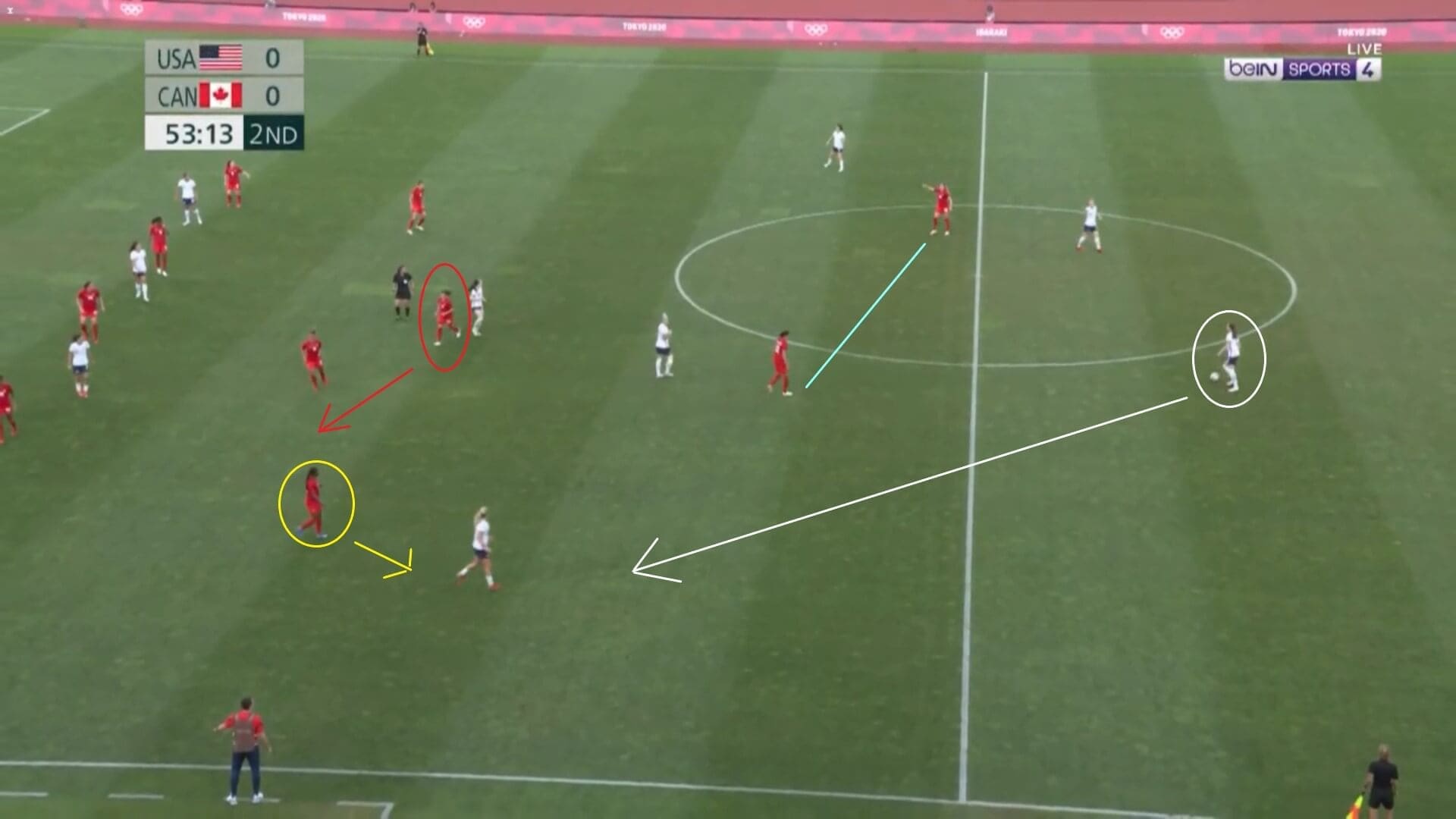
Something that was evident in Canada’s final group stage match against Team GB was their flexible positioning, and this has been a key characteristic of their play since Bev Priestman took charge. Here, we see one of the Canadian midfielders, in the red circle, moving back into position, which then allows Prince, in the yellow circle, to press forwards once the USA move the ball out to the wing. This shows how the Canadian players know their individual strengths, ensuring that every player is in their best position, and this is another reason why they are so difficult to break down.
Canada’s game control
Canada’s overall game management was also excellent, and they reacted well to different situations during the match.

In the opening stages, the USA didn’t have many players going forwards in the final third, as we have already seen, so the Canadian players knew that they had time to move the ball around at the back and wait for the best opportunity to make a forward pass. However, in order to take full advantage of the amount of time they had, they didn’t just spread out and pass along the ground but made long, aerial passes towards each wing as well. The American attackers had to expend more energy as a result, trying to force the defenders into making a mistake, but Canada’s good ball control meant that this rarely happened.

We mentioned how the USA made mistakes with their passing, and how that gave Canada opportunities to find space and increase the pressure on them. This image shows how they used those spaces to create opportunities, as Beckie is looking to do here. However, the main issue with Canada’s play once in these areas was that they occasionally lacked quality with the final pass behind the defence, which meant that their attacks sometimes broke down early and let the USA off. We have already seen why the USA didn’t score in the first half, and this is the reason that Canada didn’t either.
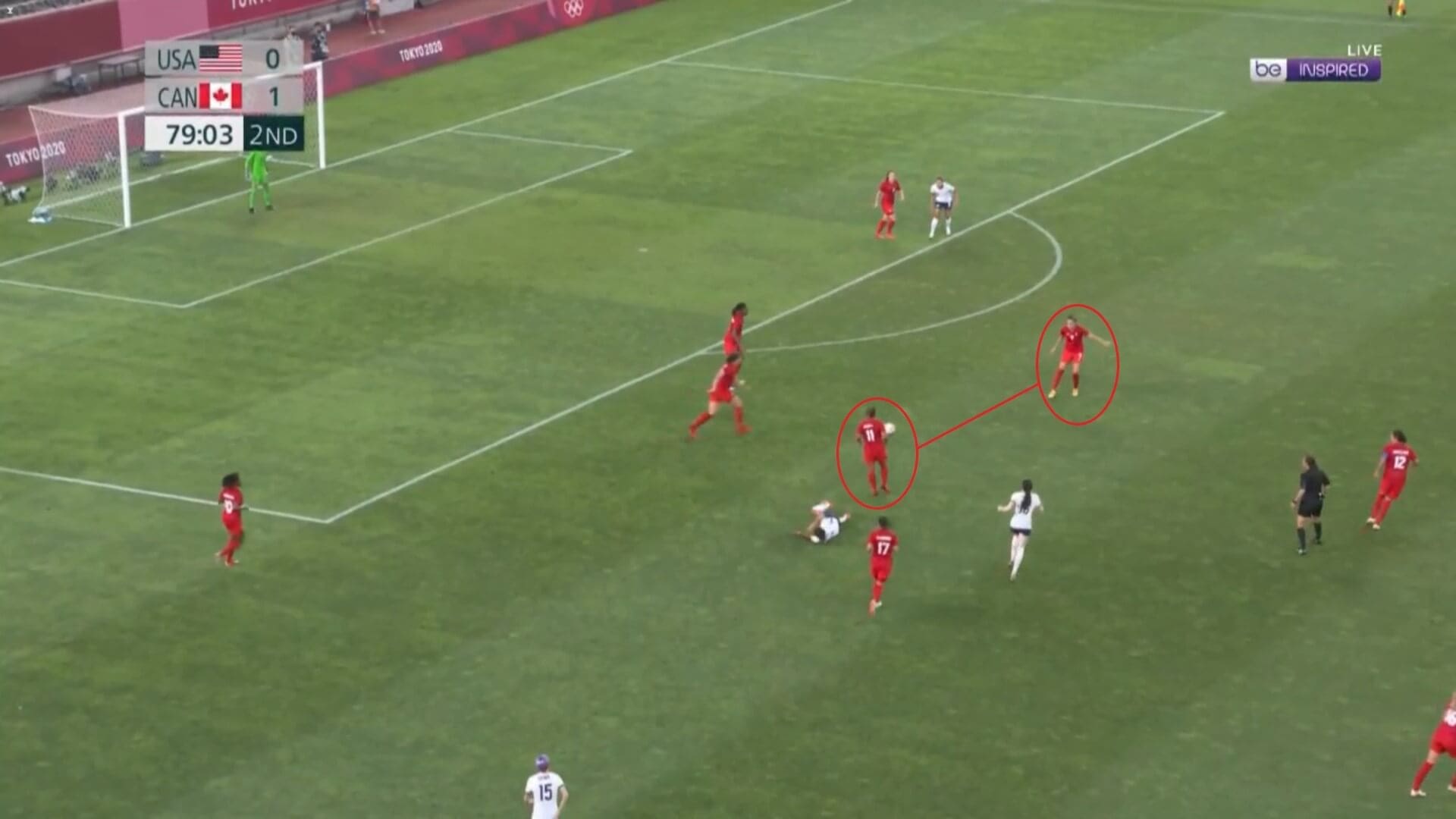
They worked on this in the second half, bringing on players who made runs behind and added more precision to their final third play, including new Reading Women midfielder Deanne Rose.
However, the substitution of Quinn for Julia Grosso was arguably the most important change they made, as she formed a defensive midfield partnership with Desiree Scott, giving Canada more defensive protection. It was interesting that she was brought on at the same time as the USA introduced Press, Lloyd and Rapinoe, and it is likely that Bev Priestman knew the defence would need more support with those three on the pitch. Whilst Quinn is more of a box-to-box player, Grosso is a battling midfielder who likes to get tight to opponents and win the ball back, so having her and Scott together meant that there were more players between the USA and the Canadian goal.
Grosso’s arrival also meant that Jessie Fleming could get further forward, supporting the attacks more. Previously, she had needed to drop back and help out in the midfield when Canada lost possession, but that wasn’t required as often once Grosso was on. As a result, Canada had more players in attack, and the added pressure on the USA’s defence led to the penalty that won Canada the match. Even though the USA were creating plenty of chances at this point, the Canadians’ ability to change their formation and tactics helped them to stay strong and stop the USA from scoring.
Conclusion
In conclusion, this tactical analysis has highlighted the reasons for Canada’s semi-final victory over the USA. Given the pre-tournament predictions for the USA, this is a shock result, even though Canada are by no means a bad team. There is no doubt that the combination of their game plan and the USA’s poor play led to the world champions being silenced, and the USA will now have to suffer two Olympics without winning the gold medal (having failed to claim it at Rio 2016 as well). They will face Australia in Thursday’s bronze medal clash, whilst Canada, who have now bettered the third place they achieved in Rio, will face Sweden in Friday’s final.





Comments